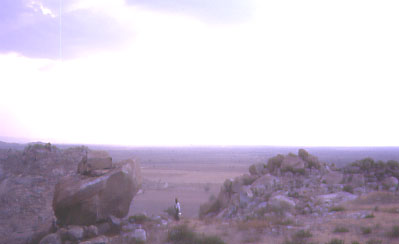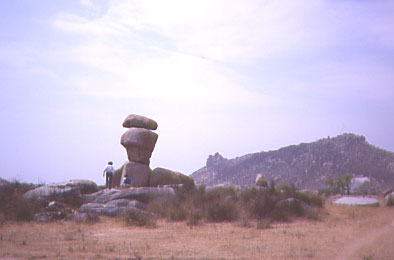The Bellary District Archaeological
Project

|
The Bellary District Archaeological Project |
 |
| Landscape
and Cosmology |
| Studies of the archaeology of prehistoric South India have thus far demonstrated little interest in exploring notions of symbolism, landscape, ritual and cosmology that have come to dominate archaeological research agendas in other parts of the world, and particularly Britain. Preliminary explorations during the course of the first field season suggested that these elements are nonetheless important to our understanding of prehistoric societies in South India. A number of interesting patterns were observed concerning the situation of Neolithic sites within the wider southern Deccan landscape. For example: · Neolithic sites are often located on tops of hills, at locales that command views over substantial distances or of other sites, or that are themselves visible from a distance. Visibility and views appear to have been important in the Southern Neolithic (see also Fuller 1999, 2001). See photo at right. · 'Special' Neolithic sites, such as rock art and ashmound sites, are often located in association with visually dramatic landscape features, such as spectacular rock formations. See photo lower right. · Neolithic sites, such as settlement sites and ashmound sites may tend to occur preferentially on the eastern slopes of hills, or on the plains to the east of hills. This pattern remains to be confirmed. Many of these patterns were observed to come together at one particular site, the Kudatini ashmound (thought to be the largest ashmound in South India; see Re-investigating Kudatini ashmound). New observations made at Kudatini suggest that this site was located to take advantage of a visually dramatic landscape formation, and its relationship to the east-west movement of the sun across the sky. Discoveries at a nearby site, Toranagallu, suggest that activities at Kudatini must be understood in the context of activities in the wider landscape. A paper by Boivin et al.(2004) explores these and other elements such as colour patterns, sensory experience, and ritual to draw new conclusions about Neolithic landscapes and cosmological frameworks in South India. |
 View across landscape from Neolithic settlement site at Sannarachamma Hill (Sanganakallu-Kupgal area)  A rock art site was discovered with the help of local informants at the rock formation shown here |
|||
 |
 |
|||